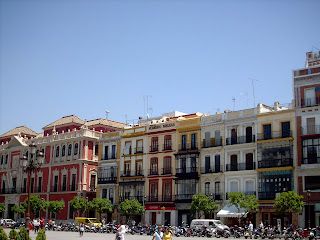The film star, the politician and the chief of police arrived courtesy of their respective chauffeurs. The rest of the twenty odd Spanish came with us, in a four hour coach trip to the mountains near the Portuguese border. But whatever their position in real life, for one week they would all be equal. They would be our victims.
Why are we “victimising” the Spanish and who are “we”? Let me explain…
The Spanish half of our group have all been learning English and have passed an audition to gauge their level. They can all ask “How do you do?”, “What is on the menu for tonight?”, “Where is the Chemist?” and hold up their end conversationally in reasonably good English, but no one has taught them that the answers could be, “Gradely”, “Bubble and Squeak” or “Next to Woollies”. That’s our job.
 “We” are a raggle-taggle bunch of volunteers chosen from every corner of the English speaking world. The answers to those questions could be delivered in accents ranging from broad Scottish to South Island Kiwi, deep southern states American to prim and proper home counties. It’s very different from what they learned in the classroom.
“We” are a raggle-taggle bunch of volunteers chosen from every corner of the English speaking world. The answers to those questions could be delivered in accents ranging from broad Scottish to South Island Kiwi, deep southern states American to prim and proper home counties. It’s very different from what they learned in the classroom.We are instructed that we are not there to teach, but to give them a taste of the “real” English speaking world. Slight grammatical and syntactical errors will be corrected, but if they don’t know the word, or the sentence is ambiguous or nonsensical, they have to rephrase or try another approach. Communication is the name of the game and a businessman at a conference or tying up the latest Spanish purchase of a foreign company cannot expect to have everything explained.
What do we talk about? A prim and proper Canadian librarian once stated, “I suppose the three taboo subjects of Religion, Politics and Sex are off the menu”. The organisers and experienced Anglos wondered what she would talk about after the second day! No subject is banned if the two having the conversation are happy with it. Likewise, neither are any words. Spanish executives at an international conference could expect to hear English in its crudest four letter terms and be expected to understand. And it amazing just how early on in the week those words become quite regular currency.
However, we are not expected to rough it. The organisers arrange for us to be comfortably housed and well fed and watered. The food is good, there is wine with every meal except breakfast and the bar is well stocked. However, we are expected to stay reasonably sober as the days are long and the students have paid the price of a good vacation to come and practice their English. We are expected to give value for money.
By the end of the second day most of the Spanish are complaining that their brains can take no more. However, on the morning of the forth day they are excitedly telling us of the dream they had in English. All Anglos begin their week speaking in slow, measured phrases. By the end of the week our victims are telling us to get on with it. Proof, if any were needed, that the system works.
Since I discovered the English Towns I have returned over twenty five times as a volunteer. But why would people with challenging jobs give up valuable vacation time to come to Spain at their own expense to talk to Spaniards? Well, even the organising companies are hard pressed to answer that one. They remain amazed that in the past eight years over five thousand of us have done so and that their books are crammed with yet more eager Anglos. About the only thing the Anglos have in common is an ability to use the internet, as that is the only way to register. We have retired bankers, young backpackers, teachers, truck drivers, nurses and bakers. In fact, a complete cross section of ordinary people. Some are academic, others practical. Some just like a good natter.
A side effect of being a volunteer is that you become such an expert on all things Spanish; From how to make the best tortilla patatas to the Spanish attitude to sustainable energy. If you want to start an argument, ask each student which region produces the best wine. If you want to get serious, ask about ETA. The politician gave me chapter and verse and the police chief told me how they were dealing with the problem. One day, the actor might play either of them in a film. But he will do so in much improved English.
(Note: I wrote the original version of this nearly two years ago and it appeared on the best website about Spain, Notes From Spain.com. Since then there have been a few changes. Primarily, the original company has split into two independent companies. They are PuebloInglés and Vaughan Village. Although they differ slightly in the way the week is organised, both will give the visiting “Anglo” a wonderful experience. I guarantee you will make good friends. And they both fulfill the aims to improve the English of the students. The results are amazing! So much so that the actor mentioned above has recently completed his first major Hollywood movie – in a leading role. When he gets his Oscar I’ll tell you who he is.)















.JPG)

.JPG)
.JPG)
.JPG)

.JPG)


















